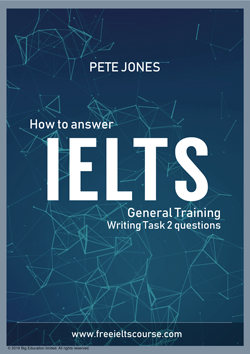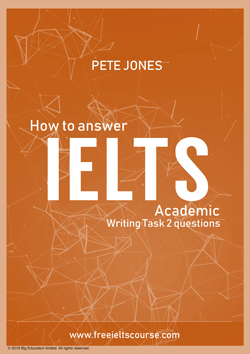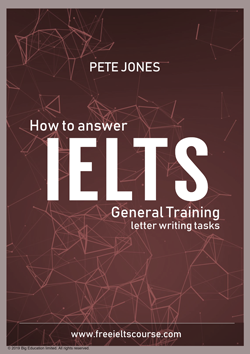A series of e-books by Pete Jones
The reviews in this issue are of a series of e-books by Pete Jones that provides a thorough understanding of what to include in, and how to organise, IELTS writing answers. The series currently comprises three e-books:
- How to Answer IELTS General Training Writing Task 2 Questions
- How to Answer IELTS Academic Writing Task 2 Questions
- How to Answer IELTS General Training Letter Writing Tasks
These three e-books can be purchased separately or in a bundle on Pete Jones’s website: https://www.freeieltscourse.com/ielts-ebooks. The first review, by Fabio Cerpelloni, is concerned with the first two books. A review of the third, by Michelle Dickson, follows. All the books in this series include a free bonus unit with extra practice questions, and further titles are planned, including How to Answer IELTS Academic Summary Writing Tasks.
How to Answer IELTS General Training Writing Task 2 Questions
by Pete Jones Big Education Ltd 2019 https://www.freeieltscourse.com/ielts-ebooks

How to Answer IELTS Academic Training Writing Task 2 Questions
by Pete Jones Big Education Ltd 2019 https://www.freeieltscourse.com/ielts-ebooks

Task 2 of both the General Training and Academic IELTS exams requires the candidates to write a formal essay (though the topics are often simpler and the questions a little easier in the General Training exam). Both of Pete Jones’s books are divided into six units, in which the reader is constantly invited to take an active approach to learning by answering targeted questions about a number of Task 2 sample answers. Involving the reader in analysis and reflection makes these e-books hands-on training guides, rather than a mere collection of sample answers or useful tips to read passively. These practical resources, therefore, not only provide useful self-study materials for IELTS candidates, but they can also be exploited in the classroom by IELTS teachers, especially those who like to adopt a model writing approach in their writing classes.
The sample answers, written by experienced IELTS teachers from the USA, New Zealand and the UK, provide excellent models and form the basis of these guides. They are accompanied by a series of specific questions about their content and organisation, which are aimed at getting the reader to understand what should be included in an essay on the topic in question, and in what order. The texts are studied in this way very clearly and methodically, starting from a more global perspective of the information that candidates should present in their answers, before moving on to a detailed examination of every single paragraph, from the introduction to the conclusion. This helps students really understand how a successful and coherent IELTS Task 2 answer is written. An answer key to the questions is provided, which makes the guides user-friendly for those students who are preparing for the exam by means of self-study, and it often contains comments for further clarification.
With these books, Pete Jones has written two IELTS guides that really stand out, as they provide support in two key areas on which IELTS candidates are sometimes offered little guidance: the content and organisation of their essays. Indeed, this is not just another IELTS resource kit about grammar, vocabulary or useful phrases to use in IELTS Writing Task 2. Too often, candidates (and teachers) are only concerned about accuracy of language use, forgetting that relevance of ideas and their organisation account for 50 percent of the assessment. Although accuracy and range of language are important in the writing exam, students are rarely supported in understanding what the task question requires and how their ideas should be organised into a coherent and logical text. These e-books assist IELTS teachers and students by giving them a complete understanding of these aspects, in order to get them to the point where they will own the task question, not the other way around.
It is also worth pointing out that these e-books would be an invaluable resource for any IELTS student, regardless of the score they need to achieve, as they cover aspects of IELTS Writing Task 2 with which even expert users of English often have some difficulty.
Fabio Cerpelloni Lazzate, Italy
The reviews in this issue are of a series of e-books by Pete Jones that provides a thorough understanding of what to include in, and how to organise, IELTS writing answers. The series currently comprises three e-books:
- How to Answer IELTS General Training Writing Task 2 Questions
- How to Answer IELTS Academic Writing Task 2 Questions
- How to Answer IELTS General Training Letter Writing Tasks
These three e-books can be purchased separately or in a bundle on Pete Jones’s website: https://www.freeieltscourse.com/ielts-ebooks. The first review, by Fabio Cerpelloni, is concerned with the first two books. A review of the third, by Michelle Dickson, follows. All the books in this series include a free bonus unit with extra practice questions, and further titles are planned, including How to Answer IELTS Academic Summary Writing Tasks.
How to Answer IELTS General Training Writing Task 2 Questions
by Pete Jones Big Education Ltd 2019 https://www.freeieltscourse.com/ielts-ebooks

How to Answer IELTS Academic Training Writing Task 2 Questions
by Pete Jones Big Education Ltd 2019 https://www.freeieltscourse.com/ielts-ebooks

Task 2 of both the General Training and Academic IELTS exams requires the candidates to write a formal essay (though the topics are often simpler and the questions a little easier in the General Training exam). Both of Pete Jones’s books are divided into six units, in which the reader is constantly invited to take an active approach to learning by answering targeted questions about a number of Task 2 sample answers. Involving the reader in analysis and reflection makes these e-books hands-on training guides, rather than a mere collection of sample answers or useful tips to read passively. These practical resources, therefore, not only provide useful self-study materials for IELTS candidates, but they can also be exploited in the classroom by IELTS teachers, especially those who like to adopt a model writing approach in their writing classes.
The sample answers, written by experienced IELTS teachers from the USA, New Zealand and the UK, provide excellent models and form the basis of these guides. They are accompanied by a series of specific questions about their content and organisation, which are aimed at getting the reader to understand what should be included in an essay on the topic in question, and in what order. The texts are studied in this way very clearly and methodically, starting from a more global perspective of the information that candidates should present in their answers, before moving on to a detailed examination of every single paragraph, from the introduction to the conclusion. This helps students really understand how a successful and coherent IELTS Task 2 answer is written. An answer key to the questions is provided, which makes the guides user-friendly for those students who are preparing for the exam by means of self-study, and it often contains comments for further clarification.
With these books, Pete Jones has written two IELTS guides that really stand out, as they provide support in two key areas on which IELTS candidates are sometimes offered little guidance: the content and organisation of their essays. Indeed, this is not just another IELTS resource kit about grammar, vocabulary or useful phrases to use in IELTS Writing Task 2. Too often, candidates (and teachers) are only concerned about accuracy of language use, forgetting that relevance of ideas and their organisation account for 50 percent of the assessment. Although accuracy and range of language are important in the writing exam, students are rarely supported in understanding what the task question requires and how their ideas should be organised into a coherent and logical text. These e-books assist IELTS teachers and students by giving them a complete understanding of these aspects, in order to get them to the point where they will own the task question, not the other way around.
It is also worth pointing out that these e-books would be an invaluable resource for any IELTS student, regardless of the score they need to achieve, as they cover aspects of IELTS Writing Task 2 with which even expert users of English often have some difficulty.
Fabio Cerpelloni Lazzate, Italy
How to Answer IELTS General Training Letter Writing Tasks
by Pete Jones Big Education Ltd 2019 https://www.freeieltscourse.com/ielts-ebooks

This e-book has many features which make it ideal for those studying to take the IELTS General Training exam. In my experience, candidates struggle to prepare independently for the writing section of this exam, since it requires a thorough understanding of how to answer the exam tasks – and feedback on their attempts, whilst vital, is difficult to come by. Task 1 in the writing section of the General Training exam requires the candidates to write a letter. Pete Jones’s useful resource gives important tips on letter writing, and it breaks down the task requirements in a manner that is easy for students to follow. Furthermore, it provides valuable information which will enable them to better their writing band scores by focusing on the features that the examiners are looking for.
The exercises in the e-book are designed to take readers through a step-by-step process which enables them to understand the purpose and style of their writing. This is then further developed with a focus on how to write in informal and formal styles and, in later chapters, how to make the purpose of a letter clear. By understanding the purpose of their writing, and the required style, students are better prepared to meet the writing criteria that they will be marked by in the IELTS exam. Typically, the impact of these features on a piece of writing is often overlooked by candidates when preparing for the IELTS writing section.
The answers given for the sample tasks are all ideal responses, which means that the students are analysing high-level examples. The students are taken through a series of steps which will enable them to recognise the features of these example letters, and will then help them to emulate their structure and language in their own writing. Additionally, the ‘Tips’ sections on each page take into consideration those students who are aiming for a higher band score, making this resource appealing to candidates of all abilities.
This book stands in contrast to the many other IELTS resources on the market, which often have too much of a focus on grammar. Although grammatical range is discussed, it is done through analysing informal and formal writing styles. This means that readers consider the language they use in the wider context of what is appropriate for the audience and purpose of their writing. The material in this book is structured in such a way as to provide the outline of a successful classroom-based English language lesson. However, it would work just as well as self-study material, to be used without the support of a teacher.
Teachers who are new to teaching exam classes can sometime experience difficulty in getting their students to understand the requirements of exam tasks. This resource guides teachers and students alike by breaking down each component of what makes a good letter, and addressing the question for a range of letters with different purposes. It shows a variety of types of exam questions that the candidates may be presented with, and gives lots of practice and sample material to consider. The task at the end of each chapter, called ‘What have you learnt from this unit?’, allows readers to reflect back on the chapter, and their notes can then be used as revision material in preparation for taking the IELTS exam.
It is my belief that students will be better prepared for the letter-writing task in the General Training IELTS exam by using this resource. This e-book will make them think more carefully about what, why and how they are writing, and will, therefore, ultimately lead to them being more successful when answering the letter-writing task.
Michelle Dickson Auckland, New Zealand
Comments
Write a Comment
Comment Submitted